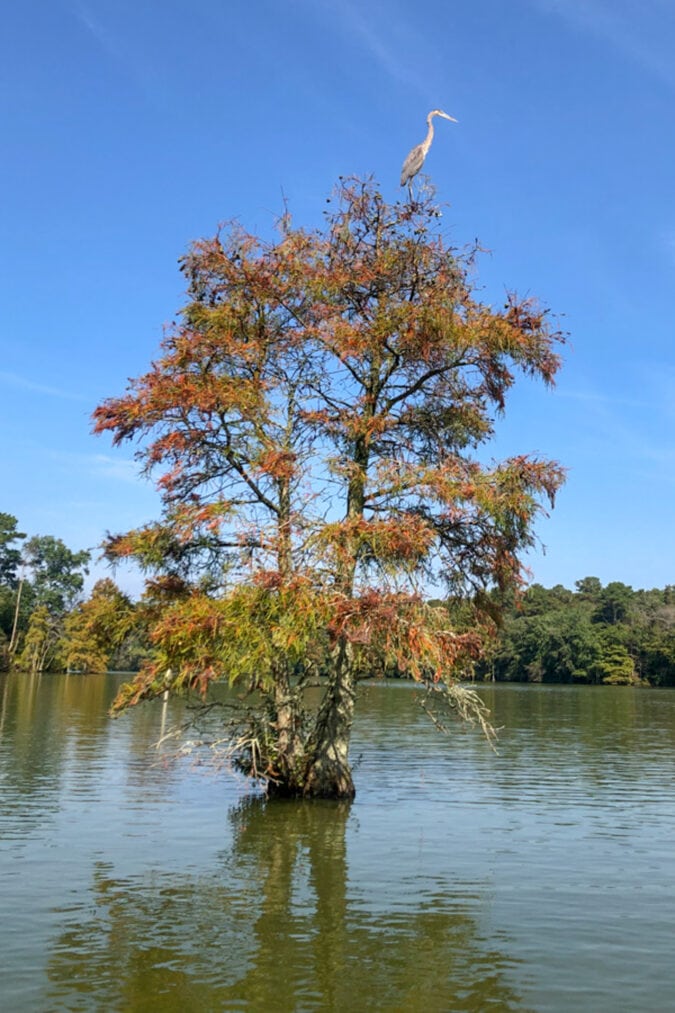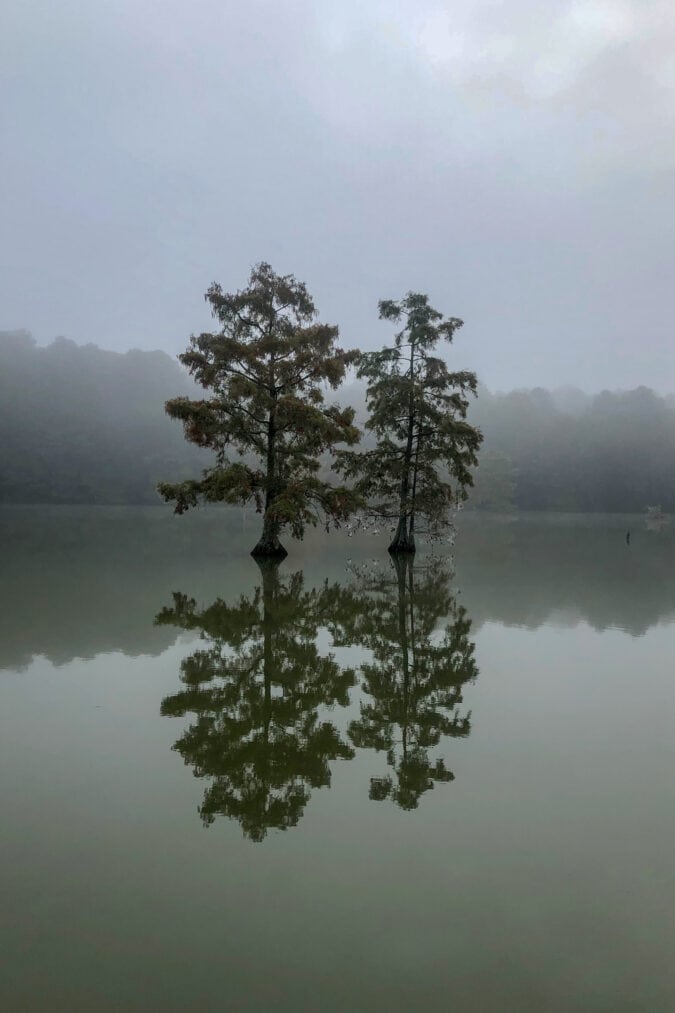Sometimes nature finds its own way to rebound—despite multiple human interferences—as any traveler to Delaware’s Trap Pond State Park can observe. The man-made pond boasts the northernmost naturally occurring stand of bald cypress trees on the East Coast. You can easily float or paddle around to appreciate these stately treasures up close.
On a foggy, atmospheric fall morning, I take a guided pontoon trip through Trap Pond with William Koth, the park’s interpretive program manager. The mist-shrouded bald cypresses rise from the water and into the air, their reflections hauntingly mirrored in the still water around us. The needles of these deciduous conifers are just starting to turn a rusty brown before falling, and our view is simply mystical.
Outlined by the dampness of the fog, spider webs glisten on several trees. Through the fog, we see a few lights from rental cabins and yurts that line the shore. We pass an island camping spot with a small bridge—the most-reserved camping site in Delaware, according to Koth.

Deep roots
“Originally, Trap Pond was an industrial logging pond,” Koth explains, although he speaks in terms of 18th century industries. In the late 1700s, when European settlers arrived in this swampy forest, they wanted to take advantage of the rot- and insect-resistant wood of the bald cypresses and Atlantic white cedar, which are common in the area. Workers dammed the small streams that ran through the area to flood it and thereby create the pond, which then helped to transport huge tree trunks to an on-site sawmill and then off to market. The hardy wood was used for ship parts, shingles, siding, and even coffins.
When most of the large trees had been removed, though, the lumbering slowed, and the water flowing over the dam was used for a while to power a grain and grist mill. In the mid-1800s, when a railroad was built nearby, the mill closed. Instead of grains, local farmers could grow and easily transport more perishable and profitable items—strawberries, melons, and peaches—northward to city markets. Driving through that part of Delaware today, you’ll still see the ditches used to drain the swampy land for farms. During a 1931 flood, the main dam washed out, thus draining the pond itself. And nature took full advantage of this temporarily transformed setting.
Bald cypress seeds require oxygen to sprout and won’t grow when submerged under water. But now, instead of dropping into water, they dropped onto drier ground. Those that had already fallen were exposed to oxygen for the first time and set down roots. (Some scientists think that bald cypress seeds can be viable for up to 25 years, Koth says.)
While the U.S. was still dealing with the lingering Great Depression, the Rural Resettlement Administration—a part of FDR’s New Deal—purchased the Trap Pond property. From 1936 to ‘37, the Civilian Conservation Corps (CCC) rebuilt the dam and added some park infrastructure. Those dry years were enough time for the bald cypress seedlings to get the jump they needed.


“They got their branches up high enough to survive the reflooding,” says Koth. “These might be some of the deepest-rooted cypresses around.”
The common rule of thumb is that a tree’s roots extend as far below ground as its crown does above. In this muddy, mucky ground, though, the bald cypresses need even more stability. Their trunks flare at the bottom as part of a “buttress root system,” Koth says, and their roots continue to flare out below ground further than the reach of their branches. That root system also includes the knobby cypress knees, which grow up through the water around the trunk. All together they “act as an outrigger for the tree,” according to Koth. In a stand like this, the roots will also intertwine underground, giving the towering trees even more stability.
Related: Why RVers love Delaware state parks
Fog and flared trunks
I think of the research from Suzanne Simard and others on the interconnectedness of trees and how they communicate and share nourishment through the mycorrhizal fungi networks near their roots. Something similar must be at work with these impressive trees, I imagine.
Turning deeper into this swampy forest, the pontoon boat plunges through a floating green plant, which I assume to be algae. Koth says it’s a native duckweed, though, which parts in front of us and closes behind. The pond’s water has a brownish tinge from the tannins and is mostly shallow, just about 18 inches in many places. That water level is ideal for the cypresses now, along with some lily pads that won’t root in deeper levels.
The flared bases of the bald cypresses can also play host to other plants. Seasonally, the water in Trap Pond can fluctuate from 6 to 8 inches, which then deposits dirt in the fissures and crannies of the base above the water. “[The flared trunks] act like little flower pots, almost like a hydroponic system,” Koth says as we identify asters growing out of several trunks. This understory may also host swamp rose, sweet spire, poison ivy, and jewelweed—none of which can grow in standing water on their own.

Later, when the sun burns off the fog, I hop into a kayak alone and retrace the well-marked kayak and canoe trail. The wide variation in weather makes me feel like I’ve visited the pond on different days. I weave closely in and out of the trunks and by their reddish knees. Dragonflies and some northern red-bellied turtles also come out with the sun to forage and bask in its warmth. Paddling through the still water, I feel as if I could wander into the pond’s farthest corners and feel completely alone in the world.
Birdsong
With the help of the Merlin Bird ID app (created by the Cornell Lab of Ornithology), I identify the songs of a blue jay, vireo, broad-shouldered hawk, and red-bellied woodpecker. My birding day is topped off by the 15 or so great blue herons I spy on both rides. I marvel at the herons’ magnificent, wide wings that carry them up and away as my kayak approaches.
In the spring, this area also provides breeding habitat for neotropical songbirds, including scarlet tanagers, Baltimore orioles, and bright yellow promontory warblers. That last, territorial bird has been known to land on the prow of the pontoon to chase interlopers away from its nest, Koth says. You also might see wood ducks, kingfishers, and ospreys hanging around. At nighttime, you can listen for great horned owls and Eastern screech owls, along with the vocal whip-poor-wills.
Around them, the once-targeted bald cypresses have rebounded beautifully—and welcome all of nature’s creatures to come play, sing, and explore among them.
If you go
Trap Pond State Park features 9 miles of kayak and canoe trails, 12 miles of wooded hiking trails, guided nature walks, and fishing opportunities. The state park offers camping and RV sites along with rental cabins, yurts, and a camp store. Kayak and canoe rentals and guided pontoon tours will resume in May.







